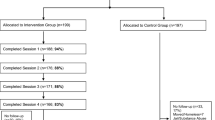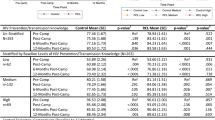Abstract
The Stages of Change (SOC) model was used to implement and evaluate a condom promotion intervention for HIV-positive and at-risk women who were recruited from clinic and community settings in Baltimore and Philadelphia. Participants were assigned to receive standard reproductive health services or enhanced services (standard plus SOC peer advocate intervention). Women who had a main partner at baseline and at a 6-month follow-up were included in the analysis (70 HIV positive, 471 at risk). Compared with the standard group, HIV-positive women in the enhanced group were significantly more likely to have progressed in the SOC model or to have maintained consistent condom use, and less likely to have relapsed or stayed in the precontemplation stage. Among the at-risk women, exposure to the intervention was associated with being at a higher SOC and being less likely to relapse relative to the standard group. The SOC model has promise for use in social and public health service settings that serve women at risk or living with HIV.
Similar content being viewed by others
REFERENCES
Bryan, A. D., Aiken, L. S., and West, S. G. (1996). Increasing condom use: Evaluation of a theory-based intervention to prevent sexually transmitted diseases in youngwomen. Health Psychology, 15, 371–382.
Cabral, R., Galavotti, C., Gargiullo, P., Armstrong, K., Cohen, A., Gielen, A. C., and Watkinson, L. (1996). Paraprofessional delivery of a theory-based HIV prevention counseling intervention for women. Public Health Reports, 3(Suppl. 1), 75–82.
Carey, M. P., Maisto, S. A., Kalichman, S. C., Forsyth, A. D., Wright, A. D., and Johnson, B. T. (1997). Enhancing motivation to reduce the risk of HIV infection for economically disadvantaged urban women.Journal of Consulting and Clinical Psychology, 1(65), 531–541.
Centers for Disease Control and Prevention. (1997a). Update: Trends in AIDS incidence—United States. In Morbid mortal wkly rep (Vol. 46, pp. 861–866). Atlanta, GA: Author.
Centers for Disease Control and Prevention. (1997b). U.S.HIV and AIDS cases reported through December 1996. In HIV/AIDS surveillance report (Vol. 8, No. 2). Atlanta, GA: Author.
Centers for Disease Control and Prevention. (2000). HIV surveillance report (Vol. 12, No. 1). Atlanta, GA: Author.
Cook, T. D., and Campbell, D. T. (1976). The design and conduct of quasi-experiments and true experiments in field settings. In M. D. Dunnette (Ed.), Handbook of industrial and organizational research. Chicago: Rand-McNally.
DiClemente, R. J., and Wingood, G. M. (1995). A randomized controlled trial of an HIV sexual risk-reduction intervention for young African-American women. JAMA, 274, 1271–1276.
Ehrhardt, A. A., Exner, T. M., and Seal, D. W. (1997). A review of HIV interventions for at-risk women. In The effectiveness of AIDS prevention efforts (pp. 236–275). Washington, DC: American Psychological Association Office on AIDS.
Evers, K. E., Harlow, L. L., Redding, C. A., and LaForge, R. G. (1998). Longitudinal changes in stages of change for condom use in women. American Journal of Health Promotion, 13, 1, 19–25.
Fishbein, M. (1996). Great expectations, or do we ask too much from community-level interventions? American Journal of Public Health, 86, 1075–1076.
Fogarty, L. A., Heilig, C. M., Armstrong, K., Cabral, R., Galavotti, C., Gielen, A. C., and Green, B. M. (2001). Long-term effectiveness of a peer-based intervention to promote condom and contraceptive use among HIV-positive and at-risk women. Public Health Reports, in press.
Galavotti, C., Saltzman, L. E., Sauter, S. L., and Sumartojo, E. (1997). Behavioral science activities at the Centers for Disease Control and Prevention: A selected overview of exemplary programs. American Psychologist, 52, 154–166.
Hobfoll, S. E., Jackson, A. P., Lavin, J., Britton, P. J., and Shepherd, J. B. (1994). Reducing inner-city women's AIDS risk activities: A study of single, pregnant women. Health Psychology, 13, 397–403.
Ickovics, J. R., and Yoshikawa, H. (1998). Preventive interventions to reduce heterosexual HIV risk for women: Current perspectives, future directions. AIDS, 12(Suppl A):S197-S208.
Kalichman, S.C., Carey, M. P., and Johnson, B.T. (1996). Prevention of sexually transmitted HIV infection:Ameta-analytic review of the behavioral outcome literature. Annales of Behavioral Medicine, 18, 6–15.
Kelly, J. A., Murphy, D. A., Washington, C. D., Wilson, T. S., Koob, J. J., Davis, D. R., Ledezma, G., and Devantes, B. (1994). The effects of HIV/AIDS intervention groups for high-risk women in urban clinics. American Journal of Public Health, 894, 1918–1922.
Milstein, B., Cabral, R., Galavotti, C., et al. (1996). Women's use of HIV prevention peer counseling. Paper presented at the American Psychological Association Women's Health Conference, Washington, DC, Sept. 1996.
Misovich, S. J., Fisher, J. D., and Fisher, W. A. (1997). Close relationships and elevated HIV risk behavior: Evidence and possible underlying psychological processes. Review of General Psychology, 1(1), 72–107.
NIMH Multisite HIV Prevention Trial Group. (1998). The NIMH multisite HIV prevention trial: Reducing HIV sexual risk behavior. Science, 280, 1889–1894.
O'Leary, A. O., DiClemente, R. J., and Aral, S. O. (1997). Reflections on the design and reporting ofSTD/HIVbehavioral intervention research. AIDS Education and Prevention, (Suppl. A, Vol. 9), 1–14.
Posavac, E. J., and Carey, R. G. (1980). Program evaluation: Methods and case studies. Englewood Cliffs, New Jersey: Prentice-Hall.
Prochaska, J. O., and DiClemente, C. C. (1992). Stages of change in the modification of problem behaviors. In M. Hersen, R. M. Eisler, and P. M. Miller (Eds.), Progress in behavior modification. Sycamore, IL: Sycamore.
Prochaska, J. O., and DiClemente, C. C. (1983). Stages and processes of self-change of smoking: Toward an integrative model of change. Journal of Consulting and Clinical Psychology, 51, 390–395.
Terry, M., Liebman, J., Person, B., Bond, L., Dillard-Smith, C., Tunstall, C. (1999). An integrated approach to AIDS prevention in high-risk communities. AIDS Education and Prevention, 11(2), 107–121.
Watkinson, L., Fogarty, L., and Gielen, A. C. (1996). Women of strength: A peer-based model. Paper presented at the American Psychological Association Women's Health Conference, Washington, DC, Sept. 1996.
Wingood, G. M., and DiClemente, R. J. (1996). HIV sexual risk reduction interventions for women:Areview. American Journal of Preventive Medicine, 12, 209–217.
Author information
Authors and Affiliations
Rights and permissions
About this article
Cite this article
Gielen, A.C., Fogarty, L.A., Armstrong, K. et al. Promoting Condom Use With Main Partners: A Behavioral Intervention Trial for Women. AIDS Behav 5, 193–204 (2001). https://doi.org/10.1023/A:1011391424690
Issue Date:
DOI: https://doi.org/10.1023/A:1011391424690




